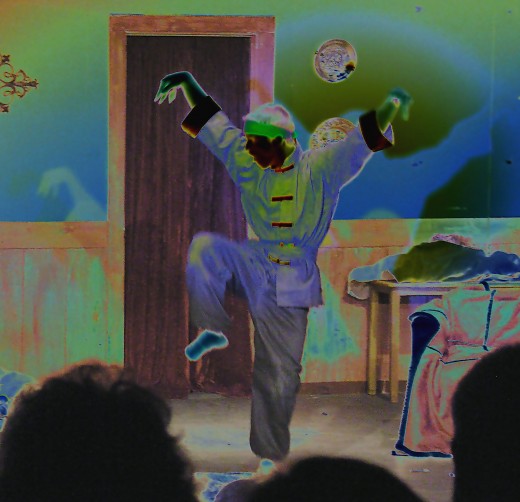Legality of using online photos/pictures/images found on or from the Internet: is there a legal use?
A photo taken by my husband that I tweaked for a commercial ezine called The Examiner.

"Only use photos you have a right to use..."
I have been wondering for a long time whether or not I am doing something illegal by taking images photographed in the 1930s and solarizing and posterizing and coloring them and basically making them my own. For your edification and mine, I decided to examine this issue.
I googled all sorts of combinations of "tweaking public art" and "legality of using someone else's photos I have tampered with" but found nothing very helpful other than admonishments about stealing copyrighted material which I already knew was wrong, wrong, wrong.
So, I went to the source, the Cornell Law School experimental site describing the Copyright Act of 1776- very confusing indeed.
- U.S. Copyright Office - Copyright Law of the United States
U.S. Copyright Office is an office of public record for copyright registration and deposit of copyright material. - U.S. Copyright Office - Can I Use Someone Else\'s Work? Can Someone Else Use Mine? (FAQ)
U.S. Copyright Office is an office of public record for copyright registration and deposit of copyright material.
Definitions
First I read through the definitions and found a few concepts I thought relevant.
A "derivative work" is a work based upon one or more preexisting works, such as a translation, musical arrangement, dramatization, fictionalization, motion picture version, sound recording, art reproduction, abridgment, condensation, or any other form in which a work may be recast, transformed, or adapted. A work consisting of editorial revisions, annotations, elaborations, or other modifications, which, as a whole, represent an original work of authorship, is a "derivative work".
The pieces I have used are preexisting and I have based my new creations on these foundational works. I have elaborated or put into place other modifications on these photographs. Therefore I would consider my new creations to be derivative works.
To "display" a work means to show a copy of it, either directly or by means of a film, slide, television image, or any other device or process or, in the case of a motion picture or other audiovisual work, to show individual images nonsequentially.
I display this derivative work on my Hub, so I guess I am displaying a work
The term "financial gain" includes receipt, or expectation of receipt, of anything of value, including the receipt of other copyrighted works.
Well, I am in a position to accept financial gain receipts from Hub Pages, however I have not received a penny as yet. Does the fantasy of remuneration count?
A work is "fixed" in a tangible medium of expression when its embodiment in a copy or phonorecord, by or under the authority of the author, is sufficiently permanent or stable to permit it to be perceived, reproduced, or otherwise communicated for a period of more than transitory duration. A work consisting of sounds, images, or both, that are being transmitted, is "fixed" for purposes of this title if a fixation of the work is being made simultaneously with its transmission.
My HubPages account is fairly permanent unless I am booted out due to illegally printing stolen photos which I have turned into derivative works.
All Art is Derivative
What does that all mean?
I decided to switch to a user-friendly site. Namely, wikipedia, where I found all sorts of great information under the title, Derivative work. According to this site, a derivative work can actually be copyrighted itself, so long as it applies the all important quality of originality to the copyrighted piece.
I did make these pieces my own in order to enhance my storyline.
Something also considered vital to my cause... In Lewis Galoob Toys, Inc. v. Nintendo of America, Inc., The appellate court said that "a party who distributes a copyrighted work cannot dictate how that work is to be enjoyed. Consumers may use ... a Game Genie to enhance a Nintendo Game cartridge's audiovisual display in such a way as to make the experience more enjoyable."
Getty Images distributes copyrighted work from the 1930s and 40s depicting American Life. It appears they cannot dictate how this work is to be enjoyed. I enjoyed reimagining it.
Then there is this whole fascinating area called Transformativeness, in which a derivative piece may transcend the original piece.
And Fair Use... In Kelly v. Arriba Soft Corporation, the Ninth Circuit held that copying an entire photo to use as a thumbnail in online search results did not weigh against fair use, "if the secondary user only copies as much as is necessary for his or her intended use."
The Wikipedia site on Fair Use explains, "The modern emphasis of transformativeness in fair use analysis stems from a 1990 article by Judge Pierre N. Leval in the Harvard Law Review, Toward a Fair Use Standard which the Supreme Court quoted and cited extensively in its Campbell opinion. In his article, Judge Leval explained the social importance of transformative use of another's work and what justifies such a taking:
I believe the answer to the question of justification turns primarily on whether, and to what extent, the challenged use is transformative. The use must be productive and must employ the quoted matter in a different manner or for a different purpose from the original. ...[If] the secondary use adds value to the original--if the quoted matter is used as raw material, transformed in the creation of new information, new aesthetics, new insights and understandings--this is the very type of activity that the fair use doctrine intends to protect for the enrichment of society.
Well from this perspective, my use of this original photograph has created a new aesthetic as I used its raw material to communicate my storyline for the enrichment of society. Therefore I cannot be successfully sued.
Fair use of copyrighted works
- U.S. Copyright Office - Fair Use
Factsheet on fair use of copyrighted works.
Copyright Law
Fair Use- the four important questions
The four fair use factors:
1. What is the character of the use? Is trade actually or potentially diverted from the copyright owner to me?
* Nonprofit * Educational * Personal
* Criticism * Commentary * Newsreporting * Parody * Otherwise "transformative" use
* Commercial
If I fall among the first list, I am okay. If I fall into the third category I am in trouble. I am in the middle, i.e., otherwise transformative use but because I am using it for Personal and Educational use, I am pretty okay.
2. What is the nature of the work to be used?
* Fact * Published
* A mixture of fact and imaginative
* Imaginative * Unpublished
Again, the first category works in my favor and the last works against me. I am in the first category as I have published this online. The middle way is irrelevant here.
3. How much of the work will you use?
* Small amount
* More than a small amount
I used a small amount of the work. I am weighing in on the side of fair use.
4. What effect would this use have on the market for the original or for permissions if the use were widespread?
* After evaluation of the first three factors, the proposed use is tipping towards fair use
* Original is out of print or otherwise unavailable * No ready market for permission * Copyright owner is unidentifiable
* Competes with (takes away sales from) the original * Avoids payment for permission (royalties) in an established permissions market
My use includes both the first category here and the second category. I am not going to compete in any way with the original.
I can sleep well tonight!
© 2009 Barbara




